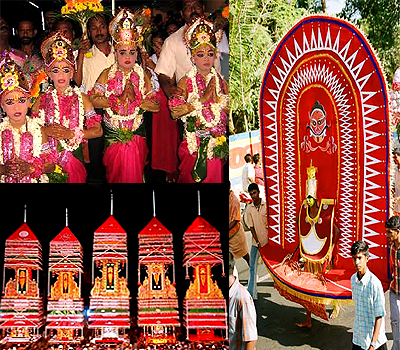 The festivals of Chettikulangara Bhagavathi Temple in Kerala are celebrated according to the Malayalam month and star. The Temple has a several festivals. The major ones are Parayeduppu, Kumbha Bharani, Ethirelpu Ulsavam and Aswathy Ulsavam. They are described below:
The festivals of Chettikulangara Bhagavathi Temple in Kerala are celebrated according to the Malayalam month and star. The Temple has a several festivals. The major ones are Parayeduppu, Kumbha Bharani, Ethirelpu Ulsavam and Aswathy Ulsavam. They are described below:
Parayeduppu
The "Parayeduppu" period is considered as the festival season. It begins when the deity of Chettikulangara temple is taken out in procession for Parayeduppu on the Makayriam star of the Malayalam month Makaram. The festivals are celebrated till the end of Medam. The main part of the festival is the Jeevatha that is constructed in the model of the temple structure. This box-like carriage rests on two teakwood poles and looks like a palanquin. The front looks like "Thidambu" behind which is a kind of pettakam as per calculations of Thachusasthra. In the front on the upper part is a woollen cloth that is embroidered with shining, colourful pictures and gold trinkets. The deity`s holy dress is kept behind this. It is decorated with small mirror pieces.
Kumbha Bharani
Kumbha Bharani is another major festival. It is held in the month of Kumbha (March or April). The day on which it is celebrated is the star Bharani and hence the name Kumbha Bharani. Kuthiyottam and Kettukazhcha are major highlights of this festival. The preparation for this festival starts days before the actual day and that day will be the Shivarathi. All these days people host public get-togethers and arrange food. The children will be taught Kuthiyoota chuvadukal. The Kuthiyottam processions starts early in the morning and will last until afternoon. Those who had offered Kuthiyottam to Devi will bring their children to the temple and will offer the children before Devi as sacrifice. The boys will be playing the Kuthiyootam dance before the deity. During the evening Kettukazhcha takes place. People from each area pull the Kettukazhcha from the construction sites to the temple.
The image of Devi will be carried in procession to the Kettukazhcha during the night. Bharani Chanda is also a part of this festival.
Ethirelpu Ulasvam
Ethirelpu Ulasvam is the annual temple festival. On the tenth day the annual festival is celebrated for thirteen days. Each day of the festival is organized by residents of each Kara. Every afternoon, cultural processions start forms each Kara to the temple premises. These processions are accompanied with drums, ornamented umbrellas, kuthiyottam songs, display of events from the Mahabharata and the Ramayana, classical art forms, folk art form and different types of music, decorated structures and caparisoned elephants.
Thottampattu is sung during the rituals. This is a devotional song sung that is by a certain community who reside in the far off Trivandrum.
Aswathy Ulsavam
Aswathy Ulsavam is held on the Aswathy day in the Malayalam month of Meenam. This festival is imagined as a send off to the Chettikulangara Amma on her journey to visit her mother at Kodungallur. In the evening hundred decorated and different effigies are brought to the temple that are made by the children. The number of Kettukazhchas provided a visual impact. Bhagavathy visits the four karas that surrounds the temple for Parayeduppu and official Anpolis are given by Kara leaders.
By dawn she leaves and seeks permission to leave for Kodungallur. The people of the first four karas make Polavilakku during this procession. A grand farewell procession is held with Aappindi that is embellished with crackers, pookkula and will be covered with tender banana stems and Thalapppoli.
Post procession, she again visits the Upaprathishtas and asks the people and other gods to let her visit her mother at Kodungallur. She proceeds towards west after dawn. The temple remains closed for the day and would be opened only the day after. Aswathy Ulsavam concludes the five month long festivities of the temple.





















